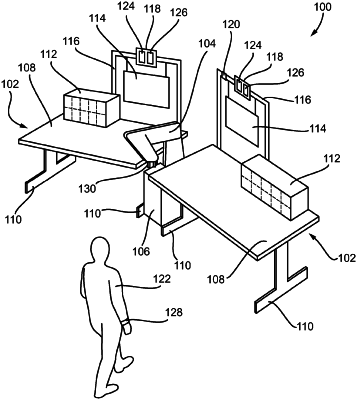| CPC B25J 9/1697 (2013.01) [B25J 9/1676 (2013.01); B25J 9/1687 (2013.01); B25J 19/06 (2013.01); G05B 19/418 (2013.01); G05B 2219/40202 (2013.01)] | 13 Claims |

|
1. A method for a workbench system, the workbench system comprising a workbench, a multi-axis robot comprising an end effector for holding an object, a visible light projector, a camera, a container comprising a plurality of compartments, and a controller, the workbench and the robot being located in a common workspace, the method comprising:
determining, by the controller, a movement operation for the robot, the movement operation being such that the robot presents multiple different views of the object held by the end effector to the camera;
using the determined movement operation, controlling the visible light projector to project a visible light indication onto at least one of a surface of the workbench and a surface of the workspace;
controlling, by the controller, the visible light projector to project a visible light indicator onto the container, thereby to indicate a specific one of the plurality of compartments;
controlling, by the controller, the robot to perform the movement operation;
controlling, by the controller, the camera to capture images of the multiple different views of the object held by the end effector; and
performing, by the controller, a validation process using the images captured by the camera,
wherein the visible light indication indicates a limited area of the workbench and/or workspace, the limited area corresponding to a limited volume of space,
and
wherein the movement operation is such that, if the robot performs the movement operation, the robot moves entirely within only the limited volume of space.
|